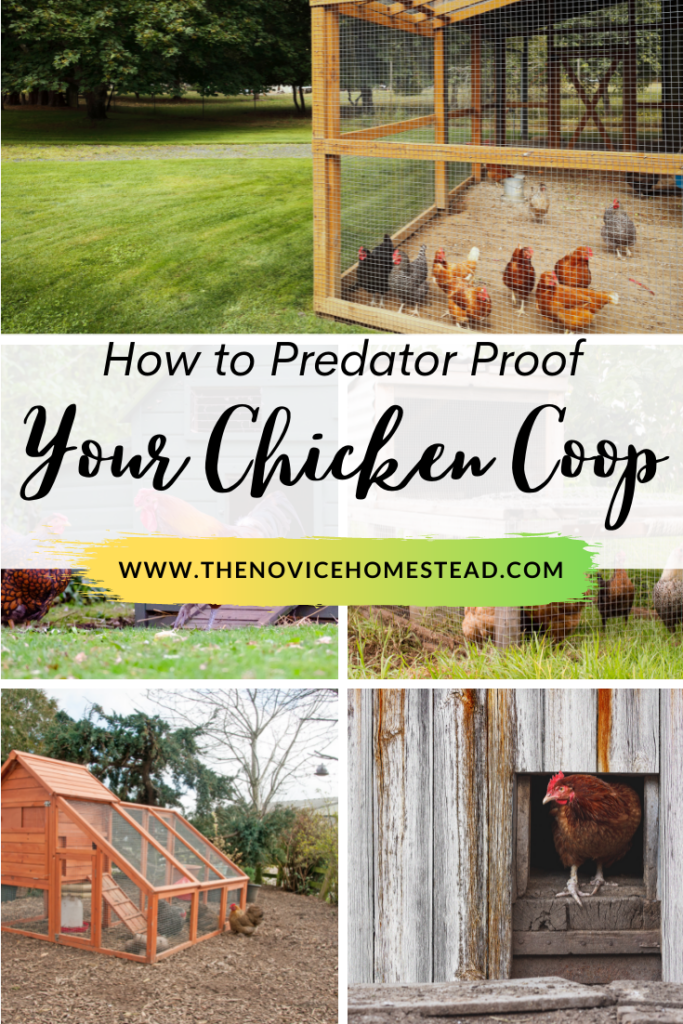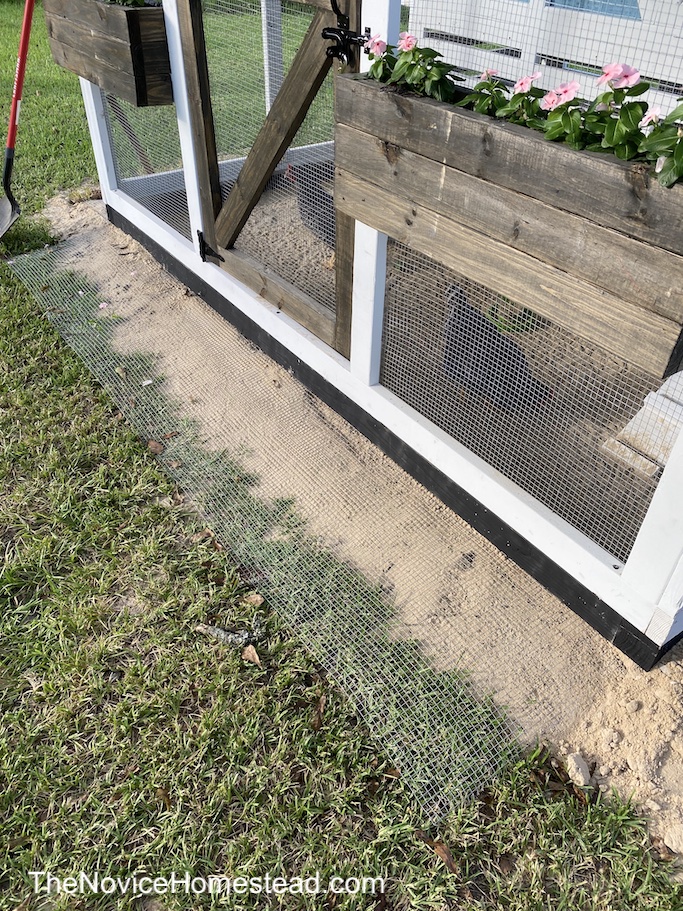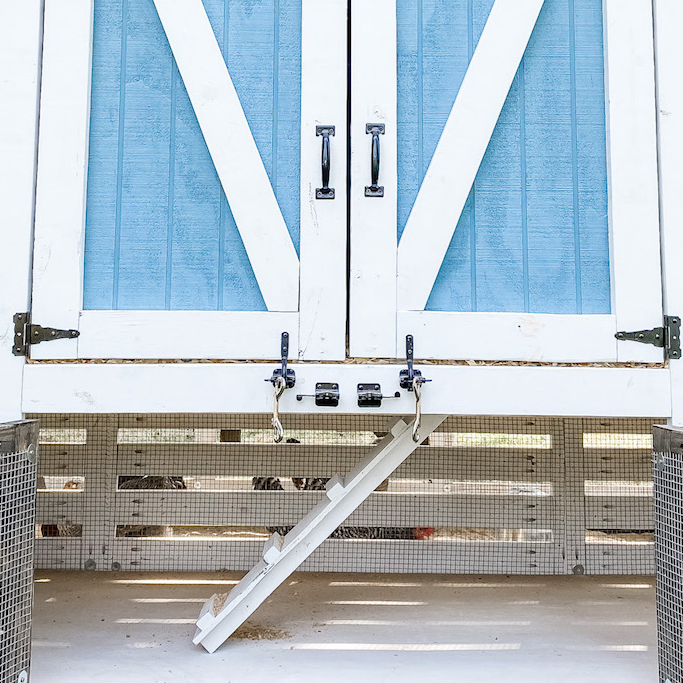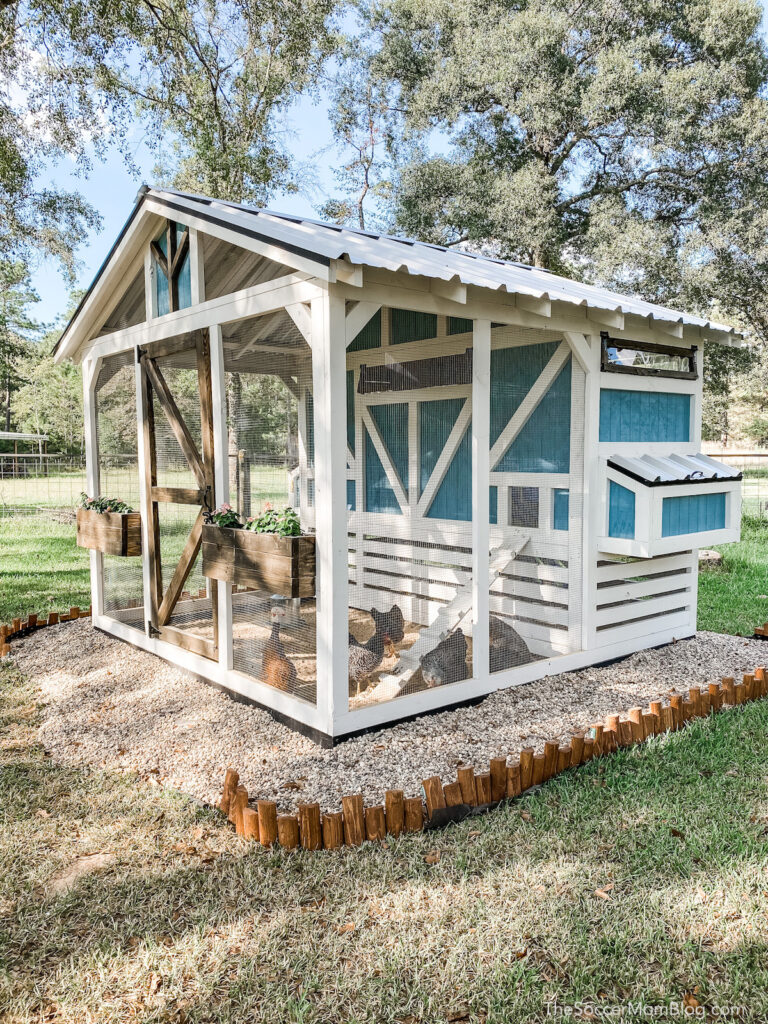10 ways to build a strong chicken coop and keep your flock safe from predators.

How to Make Your Chicken Coop Safe from Predators
A predator attack is every chicken owner’s worst nightmare. And unfortunately, it happens to all of us at some point.
However, there are steps you can take to increase the security of your coop and protect your flock. I am going to share some of the things we have done to make our new coop safer and stronger than our first coop.
As I write this, I remember our first (and thankfully only) predator attack. It was one of the worst days on our homestead. A pack of stray pitbulls (yes, you read that correctly), got through our perimeter fence, through our backyard fence, and ripped open our coop. They killed 5 birds.
I am telling you this story not to scare you, but to let you know that I’ve been through it. While absolutely devastating, this dog attack exposed weaknesses in our property itself and our chicken coop.
We used this as a learning experience to rebuild a better, stronger coop. And while you can never prevent every single possibility, you CAN do everything in your power to give your birds the safest environment possible.
1. Use Hardware Cloth Instead of Chicken Wire
Chicken wire, also known as poultry netting, is great at keeping chickens IN. However, it’s not nearly as effective at keeping predators OUT.
For one, snakes can easily squeeze through the holes in chicken wire. Small animals such as rats and weasels may be able to work their way through as well. Not only are these small animals known egg thieves, they are also dangerous to your birds.
Related: Learn more about how to keep snakes out of your chicken coop here!
Chicken wire is also fairly easy for larger animals to tear open. If given enough time, raccoons and possums may be able to rip an opening large enough to squeeze through. Big predators, such as dogs and foxes will make quick work of wire too.
By contrast, the openings on hardware cloth are much smaller and it is much tougher. While not impossible, most predators will not be able to tear it apart.
Look for hardware cloth that sized 1/2″ or less (we used 1/4″) to prevent snakes and small animals from squeezing through.
Hardware cloth is more expensive than chicken wire, but well worth the cost.
2. Bolt it Down
Staples might be the easiest way to fasten wire to your coop or run posts. However, regular sized staples can easily be pulled out.
Wood staples are a much safer and sturdier option. There are two types of wood staples: those that need to be hammered in and a pneumatic stapler. Use the longest staples as possible — as long as you can go without punching through the other side of the wood. For ours, this was 1 1/4″ wood staples. Something small like 1/2″ is not going to be strong enough
In addition to wood staples, I recommend reinforcing with washers and bolts on the corners and in the middle of a long piece of hardware cloth. This provides extra strength and makes it harder to pull staples out, since there are bolts screwed into the wood as well.
3. Add an Apron
An apron is an extra length of hardware cloth that extends down past the bottom of the coop. It is then buried to prevent predators from digging into the coop. If you have dogs, coyotes, foxes, etc. in the area, this is a worthwhile addition to your coop.
The minimum length for an apron would be about 6 inches, but I recommend at least 1 foot for best coverage.

After burying our apron, we also covered with weed blocking cloth and gravel to keep weeds from taking over close to the coop AND make it even harder to dig.
Note: We’ve included shop-able ad links in this post to products we love and use in our own home; read our disclosure policy here.
4. Use Complex Latches
Believe it or not, some animals (raccoons come to mind) are quite crafty and can figure out how to open simple latches. For example, a hook and eye latch is not a secure choice for your coop, as it can easily be lifted.
Instead, use a bolt latch and/or use a carabiner or double-ended bolt snaps to further secure your closures.

5. Reinforce the Door
The door is an area of weakness in any coop. That’s because there is usually one latch in the middle, so it can be pushed from the bottom, potentially creating an opening large enough for a predator to squeeze through.
If possible, add a second latch near the base of the door and keep it latched when you’re not around.
6. Cover the Run
If your chickens go out into a run, leaving the top open can leave the vulnerable to predators from above. Owls, hawks, and other large birds are always on the lookout for a meal. In fact, we have a couple that regularly stalk our coop! (Though it has been fruitless for them thus far!)
Another problem with a chicken run that is open on top is that some predators can climb right in, such as raccoons. And raccoon attacks can be devastating!
If you aren’t actively watching your chickens while in the run and there is no guardian animal (which is helpful, but not foolproof), I highly recommend covering the top of your run with hardware cloth or a solid roof.
Keep in mind that while netting can keep out flying predators, it is not effective against climbers.
Our run is covered with a metal roof (which covers the coop itself). This is also practical in a hot climate, to protect the birds from the beating sun and protection from rain and storms. It helps keep the coop from turning into a mud pit too!
7. Light It Up
Lights can be an effective deterrent for many nighttime predators, such as skunks and opossums. Predators prefer to work in the cover of darkness, so keeping the area around your coop well-lit may keep some of those pests away.
Larger predators, such as coyotes, may not be as worried about lights. Depending on how hungry they are, predators can be quite bold. However, motion activated lights may startle predators and cause them to leave the area, at least temporarily. It is also a signal to check your coop and can buy you time to get outside.
Another benefit to good lighting is that you can SEE what is going on around the coop at night. I always peek out the window throughout the night, just to make sure that everything looks the way it should.
8. Keep Up with Maintenance
If you want to keep your coop safe and secure, it’s important to stay on top of any repairs as they arise. Damaged parts of the coop, run fencing, etc. can make your flock vulnerable. Fix any damage as soon as possible.
9. Remove Eggs Regularly
Eggs just sitting in the coop can be a tempting snack for smaller pests, such as snakes. Most snakes won’t go after a much larger chicken. However, they can be dangerous to have in the coop, as they eat eggs and small chicks or youth.
Furthermore, a snake that is hiding may bite and injure a bird that accidentally gets to close or steps on the snake.
Other pests that may seek out eggs include rats, foxes, skunks, opossums, crows, and raccoons, just to name a few. These creatures can also harm your birds or spread disease.
Getting freshly laid eggs out of the coop as soon
10. Lock Up
Humans can be predators too!
If you live close to your neighbors, your coop is visible from the road, etc. you may want to consider locking the coop when you are not home to prevent chicken theft. It happens more often than you might think!

This time around we worked with Clifton Visions, a local Texas builder that specializes in chicken coops, dog kennels, and other small structures. If you’re handy you can implement many of these coop updates yourself, but if you’re looking into building from the ground up, I can’t recommend Drake and the team at Clifton Visions enough!
Related: You can see a full photo tour of our farmhouse style chicken coop here!
Helpful Tools to Make a Chicken Coop Predator-Proof
One More Thing to Remember
The best predator deterrent is YOU. Pay attention to your coop and your flock. Check on them throughout the day, even if it’s just a quick peek outside. Make sure all the birds go into the coop to roost and night and that no unwelcome visitors have joined them.
There is no 100% guarantee for any strategy or coop setup. However, you can better you odds by putting in the work to make your coop as secure as possible.
Any other tips? Feel free to let me know your own ideas in the comments!
Learn More About Raising Chickens
- Guide to Raising Baby Chicks
- What is Pasty Butt in Baby Chicks?
- When Do Chickens Start Laying Eggs?
- How Often Do Chickens Lay Eggs
- Is Free Ranging Better for Chickens?
- How Cold is Too Cold for Chickens to be Outside?
- Farm Fresh Eggs 101
- How to Keep Chickens Cool in the Heat
- What is Bumblefoot & How To Treat It
Hi! I am in love with this coop, is there any way to get plans for it? Thank you so much!
Here’s the guy who builds them: https://www.facebook.com/cliftonvision
Tell him Stacey sent you! 🙂
Hi, I am critter proofing our small coop and I am using the apron idea, but I wanted to know if it was easier to attach the apron to the frame on the bottom before digging down 6 inches to 1 foot or dig down first and then attach the apron? What has your experience been with this?
Our apron was already attached before we dug. I’m not sure if that is the easiest…digging is never fun LOL…but it was do-able.